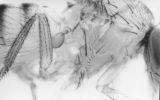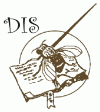      
|


      
|


Andreadis, D.K., and C.R.B. Boake. 1999. An inexpensive method for recording Drosophila song.
Dros. Inf. Serv. 82: 95-97. View PDF
We developed an inexpensive method for recording Drosophila song while observing the behaviors associated with the sounds. This apparatus was inspired by one developed by Hunt (1993) to listen to substrate vibration in leaf hoppers. We used this device to record two species of Hawaiian Drosophila, D. silvestris and D. heteroneura. The recording method allowed us to hear the sounds produced both by wing vibrations and by abdominal vibrations, which are relatively soft (Hoy et al., 1988). The entire apparatus, exclusive of the tape recorder, was purchased and assembled for less than US$200.
 |
Figure 1. The recording apparatus was attached to a ring stand and placed with the insect pin in contact with the mesh floor of the chamber. Aluminum foil shielding (shown as transparent gray to show details) was placed around the recording arm. A small piece of casing was removed from the stereo cable and electrical tape was wrapped around the foil and cable at that point (*). |
We used 8 oz clear, plastic delicatessen containers from which the floors were removed and replaced with nylon mesh (no seeum netting, from Recreational Equipment, Inc.) as recording chambers. Both D. silvestris and D. heteroneura spent most of their courtship time on the mesh. We used a phonograph cartridge (2.8 V output, Arista LC-4 Monaural crystal cartridges and 5 V ceramic cartridges both worked) in which the stylus had been replaced with a bent insect pin (size 000) as a microphone, which we placed in direct contact with the mesh (Figure 1). We were able to obtain cartridges with unusable needles from a local phonograph hobbyist store at minimal cost. The phonograph cartridge output was fed by stereo cable into an Optimus Model SA-155 stereo amplifier (Radio Shack). The phonograph cartridge and cable end were then mounted on a piece of dowel and the entire assembly, except the pin, was covered with aluminum foil. The foil was taped in place over a section of wire which had the rubber casing removed, thus grounding it to the cable. The foil was also grounded to the building ground wire. The foil shielded the cartridge and cable from electromagnetic interference. If, in using this apparatus, excess noise is still a problem, it may be necessary to construct a Faraday cage to reduce electrical noise further.
 |
Figure 2. A shows unfiltered waveform of abdominal purring, B shows same recording after filtering. |
The amplifier output was fed into an Onkyo Model TA-2600 cassette tape recorder. Recording was carried out on a vibration-isolating table in a quiet room. The table was inside a sound proof booth, but the door was kept open to allow observation of the flies' behaviors. The Hawaiian flies studied require cool temperatures, so we maintained the temperature by applying a freezer pack to the top of the chamber.
Tape recordings were exported to a desktop computer (PowerMacintosh) for analysis using Canary™ software (Cornell University). By analyzing portions of the tape with and without song, we found that we could greatly reduce background noise by filtering out signals below 100 Hz and above 600 Hz. Once filtered, we were able to analyze waveforms of the songs (Figure 2).
As a simple test of the utility of the apparatus, we used a smaller chamber with the mesh top to listen to D. melanogaster. The microphone apparatus was inverted and placed in contact with the mesh. Despite the smaller size of the flies, we were clearly able to hear the songs of D. melanogaster in a quiet room.
Acknowledgments: We would like to thank Randy Hunt for providing advice and troubleshooting expertise during the development of this apparatus. We would also like to thank Jim Hall for the use of the vibration-isolation table and soundproof booth. Funding for development of this apparatus was provided by National Science Foundation (Grant No. IBN95-14041 to CB).
References: Hoy, R.R., A. Hoikkala, and K.Y. Kaneshiro 1988, Science 240: 217-219; Hunt, R.E., 1993, Ann. Entomol. Soc. Am. 86: 356-361.